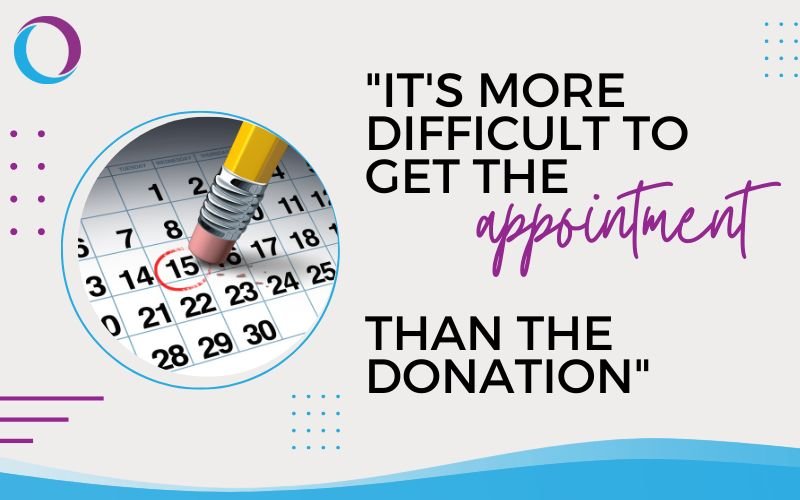Face to Face Fundraiser tips for grabbing (and keeping) attention
One of the things that a face to face fundraiser definitely has to be is confident. It really doesn’t matter how knowledgeable about a topic you are if you’re not comfortable striking up conversation in the first place!
But how about getting someone’s attention in the first place? And what about holding that attention once you’ve got it?
At the end of the day, people only invest in other people. If they don’t believe in the fundraiser, they won’t believe in the cause either. So making the best first impression is a game changer.
We look at the best ways to get strangers to notice you, along with some great fundraiser tips and techniques to stay the centre of attention once you’ve got it.
Why attention seeking ‘done right’ is important
Obviously the first thing that F2F fundraisers need to remember when thinking about how to get attention is compliance. It’s not like it’s okay to stand there with a trumpet in your undies.
To gain attention from passers-by, anyone in the fundraising business is bound by the rules in the Fundraising Code of Practice.
This is basically the ultimate guide to professional fundraising that charities and third parties who are raising funds for charities must abide by.
The code of fundraising basically acknowledges the need to ask in parallel with peoples general aversion to face to face fundraising. In other words, we have to carry on asking, but we’ll promise to do it nicely.
Read more about the code of fundraising practice here
The code came about as a way to reign in bad behaviour. Back in 2008 fundraisers seen in the street, dubbed ‘charity muggers’ – or ‘chuggers’ for short,) had a pretty awful reputation with the general public.
One disparaging study even said that almost 56% of respondent felt put off making a donation just by seeing a chugger!
It seems that the very notion of ‘being asked’ is sometimes the problem, regardless of how it’s done.
And it’s fair to say that some fundraisers weren’t helping.
An anonymous article in the Guardian by a face to face fundraiser showed the kind of bad habits that F2F fundraisers were getting into when they wrote:
“I’ve seen aggressive and deceitful fundraisers at work. I’ve heard every gimmick; it’s OK to cancel after the first month; this won’t start for six to eight weeks; this is a one-off donation; all your donations go to people in the local area.”
The writer goes on to point out that
“Fundraising isn’t intrinsically aggressive, just as the majority of fundraisers aren’t intrinsically deceitful people. There are ways to get people excited about supporting a cause without deceit.
Unfortunately, we sometimes get lazy, or desperate and I understand how easy it is, in those circumstances, to cross the moral boundary.“
The issue with being disliked isn’t just down to the fundraisers, the companies that employ them or even the fact that the media don’t often offer favourable coverage.
The issues is that charities have to prioritise money to survive. Behind every great idea to make the world a better place is a price tag. That means whatever measures up as the best return on investment is what floats - and in the past, ROI comes from face to face fundraisers - compliant or not.
There will always be people who believe that the entire charity sector should be propped up by volunteers or that anyone making an income from the industry is immoral. There’s another view that charities should just be quiet and wait for donations to flood in.
But this just isn’t real life. The bottom line is that if you don’t ask; you don’t get.
For the past decade, the CIOF (Chartered Institute of Fundraising) along with the Charity Commission and the Fundraising Regulator have worked hard to rebuild trust in the charity sector after much instability of it’s reputation.
These days, the public’s experience of face-to-face fundraising must be consistently good because the tried alternative just isn’t worth the impact on the charity sector as a whole.
Fundraisers nowadays must always protect the reputation of their charity first and foremost.
The biggest challenge of getting to the ask
Fundraising is so much more than just ‘asking for money’ and there are enough psychological based blogs about donor behaviour and why they choose to give to charity to prove it.
Obviously ‘asking’ is the basic premise, but experienced fundraisers all know that it’s much more difficult to get the appointment than it is to get the donation.
In other words, it’s about getting their attention in the first place that’s the hard bit.
Once you’ve got it, a few good fundraising skills should be enough to persuade almost anyone with means to make that regular donation.
So why is getting someone’s attention so darn hard?
In a word; Time.
These days, time is such a precious commodity that for someone to give theirs up means they must believe it worthwhile.
The other thing worth remembering is that mostly, fundraisers arrive in the spaces that donors are in for entirely different reasons.
Contrary to popular belief, fundraisers don’t’ get to choose where they go, nor do they just hang around. Instead, they are scheduled to be in places are pre-arranged locations and times.
Professional fundraisers can be booked to work anywhere from airports to supermarkets to festivals to fetes. Fundraising agencies know that booking the right venues is paramount to fundraising success. Landing fundraisers in places that have the best footfall at the right times doesn’t just happen. It takes years of research, testing and relationship building with the venue managers to ensure fundraisers have the very best chance of getting in front of the most people.
Learn more about Charity Link and fundraising venues
Basically, places there are lots of people; places those people have got money to spend.
And how often do people wander around in these types of public spaces and events without purpose? It’s not like you pop down the shop to make a donation to Macmillan Cancer Support.
The majority of people end up in these venues with completely different criteria than standing around listening to stories about people and animals in need and making a long term financial commitment.
So that brings us to the second important point to remember.
Respect the potential donors time
It definitely doesn’t mean taking ages to introduce yourself.
It definitely doesn’t mean waffling on about every single thing you know about your charity cause.
And it’s not about making it all about you.
It’s about asking questions and finding out about them, speaking to them in plain language that resonates, being engaging and interesting, lifting their mood with your enthusiasm and most of all talking about how their money will make a real difference.
Once the two golden rules of being compliant and not time wasting are well and truly embedded, it’s time to think about the best ways to get the attention of passers by (without being desperate) and hang on to it.
Food for thought – the average attention span in 2022 is just 8 seconds. Yes you read that right – 8!! That is literally less than a goldfish.
So you’d be wise to make sure you’re as interesting as possible.
5 Ways to get attention and hold on to it
Smiling
One way to create immediate joy is the simple act of smiling. It’s linked to reduced stress levels, increased health, endorphin levels and lower blood pressure.
Smiling is the universal language and it’s been compared to the same level of brain stimulation as up to 2,000 chocolate bars (source: TED Books – The Astonishing Powers of a Simple Act).
While children smile 400 times a day, that figure drops to just 20 smiles a day for just over 30% of adults. Less than 14% of people smile 5 times or less.
So it’s fair to say smiles count for a lot.
If you’re a fundraiser and you actively smile at passers by, you are far more likely to gain the go ahead to being a conversation. Even if it doesn’t they’ll have hopefully smiled back at you and you’ll feel better too!
Compliments turn heads
Much like smiling, paying someone a random compliment will not only probably make them smile, it will also completely disarm them.
If they’re not feeling defensive, then they’re much more likely to be open to a chat.
Compliments can be anything from something they’re wearing, to their baby or dog, or even remarking on a shopping bag they’ve gotten “I love that shop madam!”. A word of warning here - always watch your tone when giving compliments so they sound sincere and genuine. A good rule of thumb is that if you don’t mean it, don’t say it!
Another good tip here is to remove the potential of misconstrued ‘judgement’ - so instead of saying ‘Nice hat!’ as if you’re the judge of hats, you could say - ‘Oh I love your hat!’ which has a slightly different connotation.
Attention grabber words
There is of course verbal communication too and certain words are known to have much more throw than others.
Here are a few great words to slip into your introduction or pitch when you’re trying to get and keep someone’s attention:
Immediately
Using immediately provides a sense of urgency and can be a great way to capture someones attention. Sentences like “RSPCA immediately respond to any animal in distress” gives the feeling of priority and importance on any topic
Sharp
Sharp is psychologically powerful as it implies quick perception, keenness and clever resourcefulness. Use in phrases like “Guide Dogs that are eventually chosen from the process are extremely sharp”
Instantly
Much like immediately, instantly shows power and the ability to make things happen. Used in phrases such as “Macmillan immediately responds to cancer patients needs as and when they arise with our dedicated cancer nurses”.
Renewed
Renewed can relate to or emphasise in a mission statement promise that’s been made.
Invigorated
To invigorate means to inject fresh energy and determination, which is exactly what we need for charity campaigns. “With donations from the public, it really invigorates our campaign to build another dog rehoming centre in Birmingham. If we can get it up and running, we’ll be able to save another 3,000 dogs per year”.
Relevant
Using the word relevant means to keep the donor connected to the cause. If the fundraiser is able to identify where there might be some common ground between the charity and the prospective donor, they could use sentences like “So the breast cancer research funded by Breast Cancer Now is really relevant to your friends experience, because it means women like her stand a much better chance of survival”
Negative words like ‘fail’ ‘death’ ‘hard’ ‘difficult’ ‘bad’ ‘cost’ ‘loss’ and ‘worry’ are all no go if you’re trying to keep the conversation energized and light.
Weaving in short stories about your charity, their beneficiaries and the achievements so far really helps humanise the cause as well as evoke an emotional response. Once the listener is invested in the characters, they usually want to help.
Learn why story telling is so important to fundraising
Other positive words to throw in like confetti will really help show enthusiasm and passion. Here are a few suggestions of words that could be embedded by fundraisers that will help push things along during the pitch.
Solution
Strong
Quality
Absolutely
Clear cut
Best
Dependable
Guarantee
Benefit
Safe / Safety
Yes
You / Your
Simple
Accomplish
Achieve
Compelling
Critical
Positive
Read more about magic words in fundraising here
Get showy with your branding
Getting attention can also be visual! You’ve probably already noticed that fundraisers and charities are easily recognizable through their bright branding colours.
But you can go one step further, particularly when fundraising on private sites.
Things like roller banners, tablecloths, flags, branded toys, free gifts (pens, stickers), leaflets and posters all go toward drawing attention to you and making people look again.
If you catch someone looking, it’s your chance to give a big smile and ask an opening question.
Attention positive body language
Much like smiling and eye contact, good body language goes a long way towards drawing people in for conversation.
Having a stance that communicates to strangers that you’re welcoming and inviting communication gets the attention and kicks off in the best way.
Here are 8 positive body language cues you might want to adapt:
Take up space
By standing with your feet a little wider than hip distance, you’re showing others that you’re comfortable and at ease which is non threatening
Perfect posture
Watch your posture with a straight back and relaxed shoulders. This gives off the air that you’re completely comfortable in your environment which in turn makes them more comfortable around you
Lean in
Create an air of intimacy by leaning in very slightly towards the person you’re talking to. This creates trust and sincerity as well as showing that you’re actively listening. Being attentive to everything that’s said makes the person feel they’re important
Let your arms hang
Let your arms hang easily by your sides leaving your chest open. This is clear signal that you’re open to communicating an are not defensive.
Wave
Waving at people with ‘hello’ gesture is a good way to get attention in the first place. During an exchange, emphasise words with your hands to help get your point home. Be careful not to over do it, but definitely let your hands do the talking
Shake hands
Offer to shake hands when someone first comes over. Make sure your handshake is firm enough to relay confidence, but not so firm it crushes the other persons hand! A handshake is a powerful way to assert yourself, so make sure you keep eye contact and are smiling when you do so. These days it’s a good idea to offer hand sanitiser as standard for safety against covid as well as coming across as thoughtful
Comfortable eye contact
Eye contact is important in all communication. The person listening should typically be the one continually looking at the speaker, nodding to show engagement. The person talking should blink regularly and look away occasionally to stop the interaction feeling too intense.
Head movements
Nodding, tipping the head to one side slightly are actions that let people know you sympathise with them and understand what they’re saying.
The whole experience should go down in the memory banks as ‘good’.
If someone is kind enough to stop and have a conversation with you, use their time wisely and create a good emotional journey that’s about them.
Don’t overload with emotion; rather try to sprinkle it within the pitch. Fun fact; children who were given an entire chocolate bar have significantly less feelings of joy than children who are given the same amount of chocolate but intermittently. Basically if you want the potential donor to remain moved by the plight of your charity, then have meaningful titbits to feed into the conversation regularly. Provide joy, then take it away – go for happy / sad / happy /sad patterns to keep engagement and attention.
Learn more about emotion in fundraising
And on a final note, know that if you’ve successfully held a persons attention, they are far more likely to go out and share your message with others. Afterall, don’t we all love to spread news of things that have interested and engaged us?
Always always thank them promptly for their time, their contributions (even if it was just encouragement or listening) and end with a smile.
Charity fundraising is a career for anyone with passion, people skills and drive! If you’re thinking about a change in job, why not reach out to our in-house recruitment team today? Charity Link are a UK based fundraising agency that are always on the look out for the right people to recruit and train up as professional fundraisers with our award winning training academy.
Benefits include a comprehensive healthcare package helping you to redeem up to £900 worth of treatments, a perks at work scheme enabling you to collect points and discounts and thousands of retail stores, flexible holiday, death in service, incentives and a pension.
Learn more about our charity fundraising jobs HERE Or just contact us direct to see if we’re a good fit!









